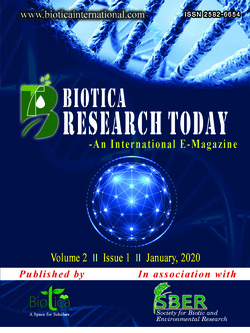
Heavy Metals Impediments the Crop Yield
Selukash Parida*
Dept. of Plant Physiology, Orissa University of Agriculture and Technology, (OUAT), Bhubaneswar, Odisha (751 003), India
Prajjal Dey
Dept. of Plant Physiology, Orissa University of Agriculture and Technology, (OUAT), Bhubaneswar, Odisha (751 003), India
Joy Kumar Dey
Dept. of Agronomy, Institute of Agriculture, Visva-Bharati, Sriniketan, West Bengal (731 236), India
DOI: NIL
Keywords: Crop, Heavy Metal, Productivity, Yield
Abstract
Heavy metals are generally defined as metals with relatively high densities, atomic weights, or atomic numbers. A density of more than 5 g/cm3 is sometimes quoted as a commonly used criterion and is used in the body of this article. Heavy metals affects morpho- physiological and biochemical processes in the plants. Chromium, arsenic, cadmium, mercury, and lead have the greatest potential to cause harm on account of their extensive use, the toxicity of some of their combined or elemental forms, and their widespread distribution in the environment. Application of agro-based chemical fertilizers and pesticides with high heavy metals content should be avoided to keep high quality soils for sustainable use in the reservoir watershed and to prevent human and livestock health hazards and induce agricultural plant productivity.
Downloads
not found
Reference
Bradl, H.E., 2005. Sources and origins of heavy metals. In: Heavy Metals in the Environment: Origin, Interaction and Remediation. (Ed.) Croddy, E.A. and Wirtz, Y.Y. Elsevier, Amsterdam. ISBN: 978-0-12-08838, 1-3.
Morstein, J.H., 2005. Fat Man. In: Weapons of Mass Destruction: An Encyclopedia of Worldwide Policy, Technology, and History. ABC-CLIO, Santa Barbara, California. ISBN 978-1-85109-49, 5-0.
